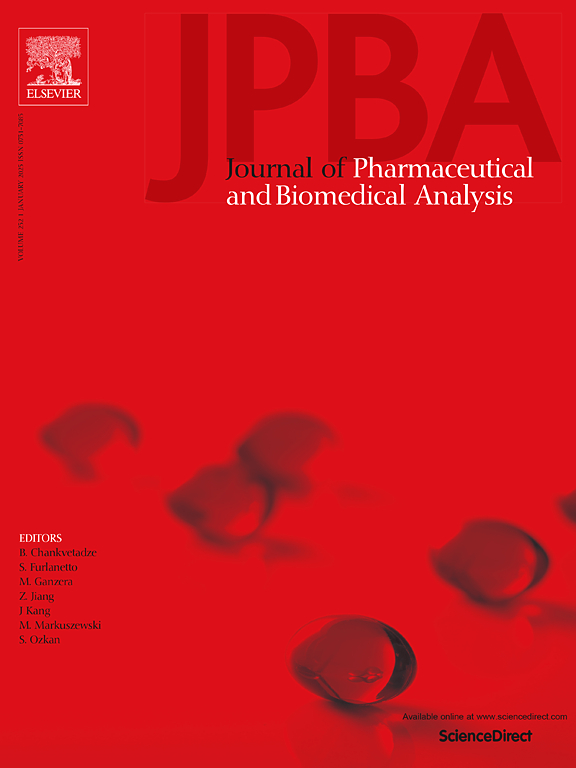High throughput analysis of vancomycin in human plasma by UHPLC-MS/MS
IF 3.1
3区 医学
Q2 CHEMISTRY, ANALYTICAL
Journal of pharmaceutical and biomedical analysis
Pub Date : 2025-02-04
DOI:10.1016/j.jpba.2025.116729
引用次数: 0
Abstract
An analytical assay based on ultra-high performance liquid chromatography-tandem mass spectrometry (UHPLC-MS/MS) technique for absolute quantification of vancomycin in complexed biological matrix was developed in this study. Reversed phase column with gradient elution was chosen for chromatographic separation of vancomycin and internal standard (IS) norancomycin. Sample pretreatment was performed by micro-solid phase extraction (μ-SPE) with Oasis® MAX μElution Plate (I.D., 30 μm). Multiple reaction monitoring (MRM) transition was chosen for monitoring of the analytes. For vancomycin, mass-to-charge ratio (m/z) of the MRM transition was 725.3→144.1; For norvancomycin, m/z of the MRM transition was 718.3→144.2. The running time was 3 minutes for each sample. The UHPLC-MS/MS method showed a good linear relationship (R2≥0.995) in the concentration range of 0.5–100 μg/mL. The intra- and inter-day accuracies (relative error, RE) are within the range of −3.44 %-1.50 % and precisions are between 3.48 % and 10.19 %. μ-SPE could enrich the analytes and decrease the endogenous interferences, thereby improving the selectivity and sensitivity of the method. The analytical assay is selective, accurate and reproducible. The assay was successfully applied to therapeutic drug monitoring of vancomycin in clinical application.
求助全文
约1分钟内获得全文
求助全文
来源期刊
CiteScore
6.70
自引率
5.90%
发文量
588
审稿时长
37 days
期刊介绍:
This journal is an international medium directed towards the needs of academic, clinical, government and industrial analysis by publishing original research reports and critical reviews on pharmaceutical and biomedical analysis. It covers the interdisciplinary aspects of analysis in the pharmaceutical, biomedical and clinical sciences, including developments in analytical methodology, instrumentation, computation and interpretation. Submissions on novel applications focusing on drug purity and stability studies, pharmacokinetics, therapeutic monitoring, metabolic profiling; drug-related aspects of analytical biochemistry and forensic toxicology; quality assurance in the pharmaceutical industry are also welcome.
Studies from areas of well established and poorly selective methods, such as UV-VIS spectrophotometry (including derivative and multi-wavelength measurements), basic electroanalytical (potentiometric, polarographic and voltammetric) methods, fluorimetry, flow-injection analysis, etc. are accepted for publication in exceptional cases only, if a unique and substantial advantage over presently known systems is demonstrated. The same applies to the assay of simple drug formulations by any kind of methods and the determination of drugs in biological samples based merely on spiked samples. Drug purity/stability studies should contain information on the structure elucidation of the impurities/degradants.

 求助内容:
求助内容: 应助结果提醒方式:
应助结果提醒方式:


